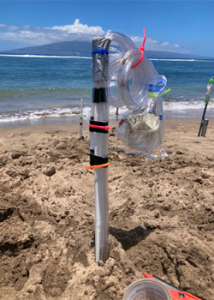
The August 2023 Lahaina wildfire may have temporarily affected water quality in nearby coastal areas, but long-term impacts appear minimal, according to preliminary results from a recent University of Hawaiʻi at Mānoa study.
Researchers monitored polycyclic aromatic hydrocarbons (PAHs), heavy metals, and a type of fecal indicator bacteria called Enterococci in waters off Lahaina Beach and Puʻunoa Beach, comparing them to unaffected areas. The study found that PAH levels in water samples were higher in September 2023 but dropped to low levels by November. PAHs were mostly undetectable in sand samples.

Low levels of heavy metals were found in both seawater and sand, but researchers noted no clear patterns over time. Bacteria levels also showed no significant trends.
“The results indicated that while wildfires may temporarily increase PAH levels, they may not increase the risk of heavy metal or microbial contamination to the coastal water environment,” said lead researchers Xiaolong (Leo) Geng, assistant professor in the UH Mānoa Department of Earth Sciences and Water Resources Research Center (WRRC); and Tao Yan, professor in the UH Mānoa Department of Civil, Environmental and Construction Engineering and WRRC.
The research team used special monitoring wells to track groundwater movement and quality in the affected beach areas. They also created a computer model to better understand how groundwater-driven substances move through the ground in Lahaina’s beach environments.
“This study helps us understand how wildfires can impact our coastal ecosystems,” Geng and Yan added. “It’s crucial information for managing environmental risks after such disasters.”
Researchers emphasize the need for ongoing water quality monitoring to ensure long-term environmental safety and to detect any delayed effects that may emerge over time. Geng and Yan’s research team plans to submit their findings for peer-reviewed publication.
The research team included Geng, Yan and UH Mānoa postdocs and students, including Yangyang Zou, Min Ki Jeon, Edward Lopez, Mackaby Pennington and Gabrielle Justine Tapat.
This study was funded by a $200,000 National Science Foundation RAPID grant.

